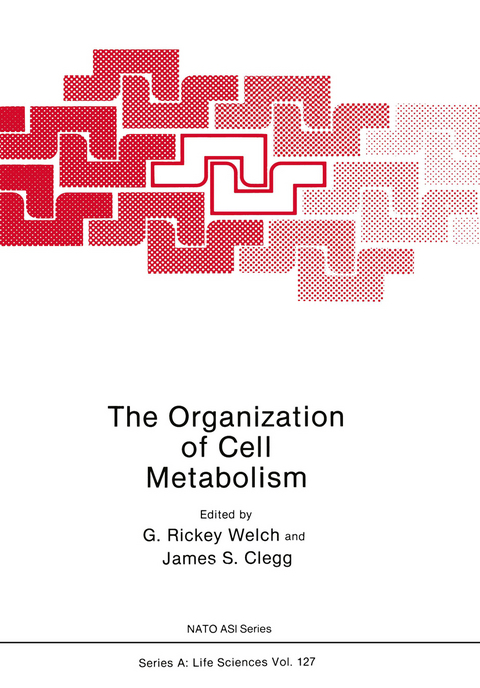
The Organization of Cell Metabolism
Springer-Verlag New York Inc.
978-1-4684-5313-3 (ISBN)
The hyaloplasmic space of eukaryotic cells has now been shown to be laced with a dense network of various filamentous structures - one role of which appears to be that of a structural support for the microcompartmentation of metabolic processe~ The supramolecular organization of certain processes may exceed the physical confines of intracellular particulates, involving large-scale entrainment of the cytoplasm in space and time.
The Organization of Cell Metabolism: A Historical Vignette.- Organization of The Cytomatrix and Aqueous Compartments.- Structural Organization of the Cytomatrix.- The Cytoskeleton.- Interactions within the Cytoskeleton.- On the Physical Properties and Potential Roles of Intracellular Water.- Diffusion of a Small Molecule in the Aqueous, Compartment of Mammalian Cells.- Restricted Motion of Cellular K+ in Permeabilized Cells.- The Intracellular Distribution of Adenosine Triphosphate.- Organization of Macromolecular Synthesis.- New Views of Cell and Tissue Cytoarchitecture: Embedment-Free Electron Microscopy and Biochemical Analysis.- Understanding the Organization of Cell Metabolism in Early Embryonic Systems: Developmental Implications.- Organization of Biosynthetic And Biodegradative Processes.- Organization of Enzymes in the Tryptophan Pathway.- Implications of Metabolic Compartmentation in Prokaryotic Cells.- Organization of Glucose Metabolism: A Model of Compartments by Poly-Isozymic Complexes.- Direct Transfer of Metabolites via Enzyme-Enzyme Complexes: Evidence and Physiological Significance.- Energetic Consequence of Dynamic Enzyme-Enzyme Interaction.- Mitochondrial Hexokinase: Interactions between Glycolysis and Oxidative Phosphorylation.- Diffusion and Perfusion in the Living Cell: Implications for Metabolic Regulation and Organization.- Organization of Energy Metabolism: Enzymological Approaches.- Interactions of Mitochondrial Matrix Enzymes with Mitochondrial Inner Membranes.- Some Aspects of Enzyme Organization in the Citric Acid Cycle.- Enzyme Interactions in the Citric Acid Cycle and the Aspartate-Malate Shuttle.- EPR Measurements of Conformational Changes on - the E1 Component of the Pyruvate Dehydrogenase Complex from Esoheriohiacoli.- Organization of Energy Metabolism: Im Situ Approaches.- Organization and Control of Energy Metabolism in Anaerobic Microorganisms.- Electron and Proton Flow in Hepatocytes during Fatty Acid and Pyruvate Oxidation: Implications for Energy Transduction and Heat Production.- Experimental Analysis of Spatiotemporal Organization of Metabolism in Intact Cells: The Enigma of “Metabolic Channeling” and “Metabolic Compartmentation”.- Functional and Structural Heterogeneity of the Inner Mitochondrial Membrane.- Experimental and Theoretical Modeling of Metabolic Organization.- Complex Patterns of Excitability and Oscillations in a Biochemical System.- Reaction-Diffusion Coupling in Immobilized Enzyme Systems: Ionic Interactions.- On Parts and Wholes in Metabolism.- Maxwell’s Demons in Channelled Metabolism: Paradoxes and Their Resolution.- Molecular Machines and Energy Channelling.- Cytosociological Aspects of Enzyme Action.- Participants.
| Reihe/Serie | Nato Science Series: A ; 127 |
|---|---|
| Zusatzinfo | 404 p. |
| Verlagsort | New York, NY |
| Sprache | englisch |
| Maße | 178 x 254 mm |
| Themenwelt | Sachbuch/Ratgeber ► Natur / Technik ► Garten |
| Naturwissenschaften ► Biologie ► Genetik / Molekularbiologie | |
| Naturwissenschaften ► Biologie ► Mikrobiologie / Immunologie | |
| Naturwissenschaften ► Biologie ► Zellbiologie | |
| ISBN-10 | 1-4684-5313-0 / 1468453130 |
| ISBN-13 | 978-1-4684-5313-3 / 9781468453133 |
| Zustand | Neuware |
| Haben Sie eine Frage zum Produkt? |
aus dem Bereich


